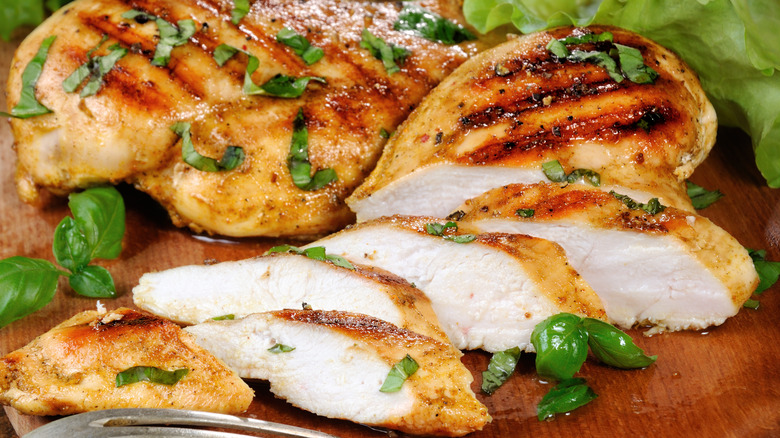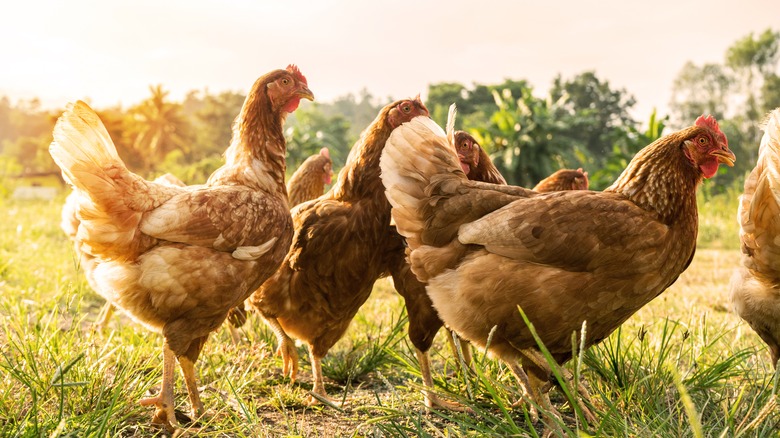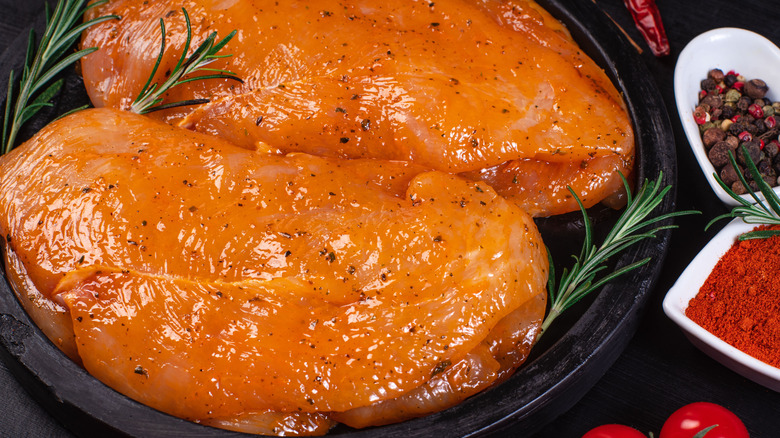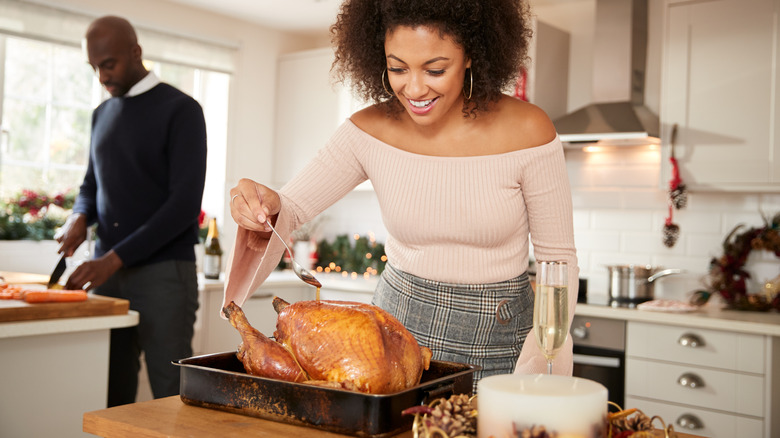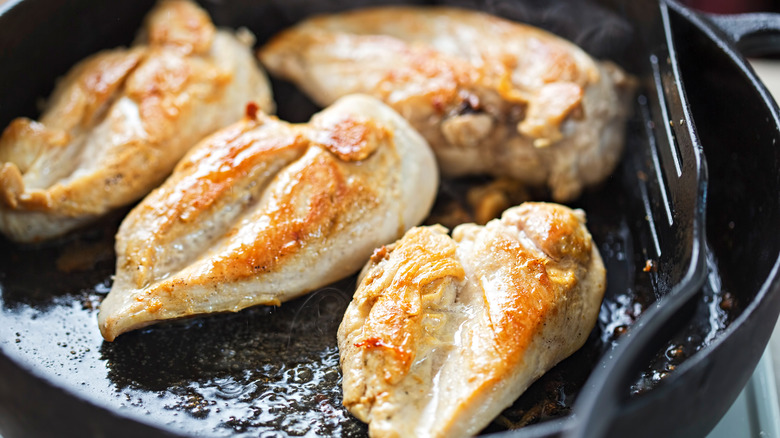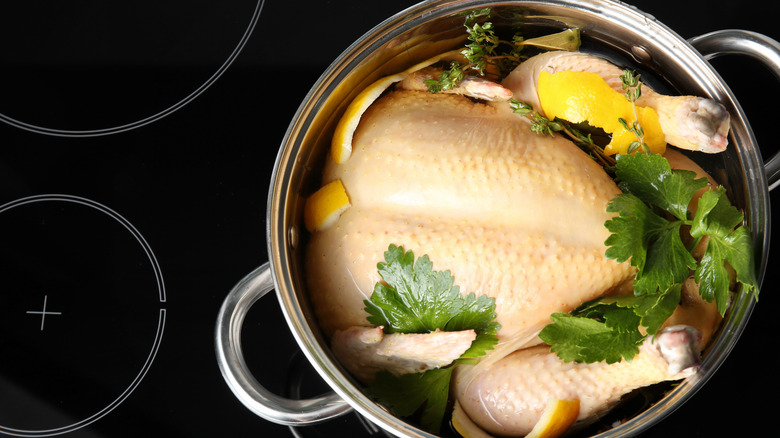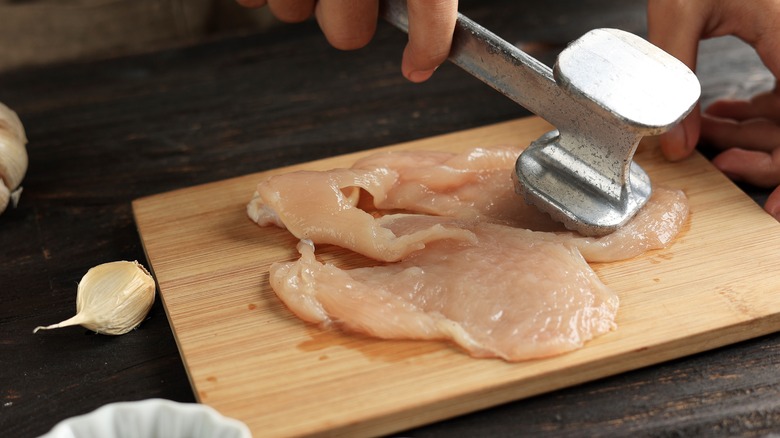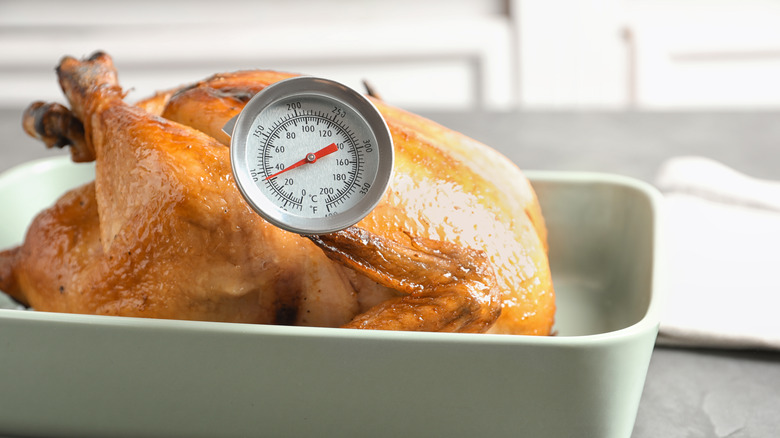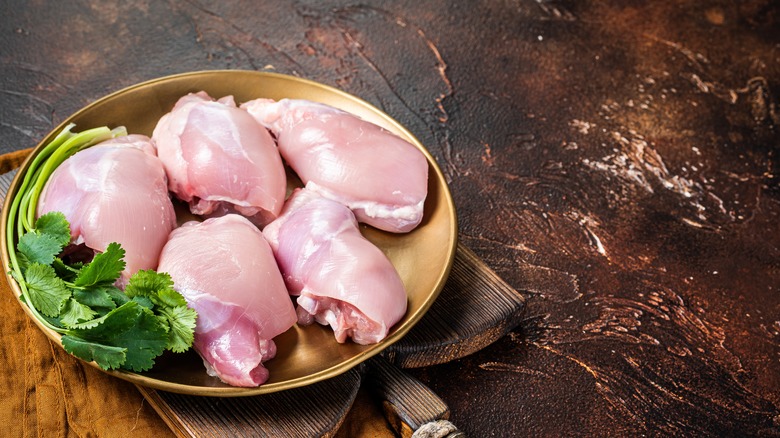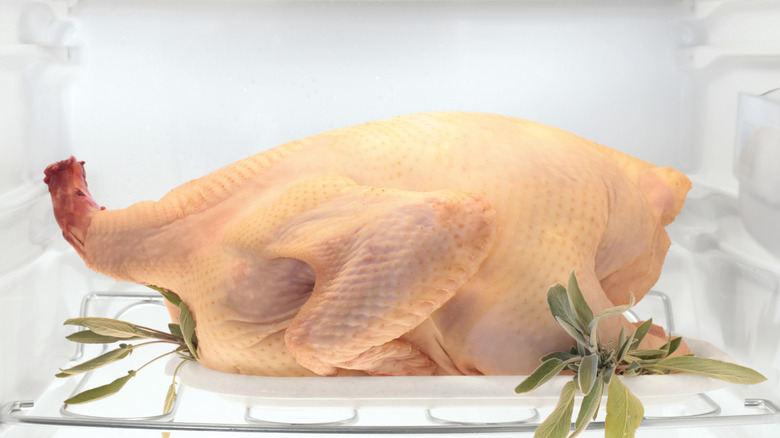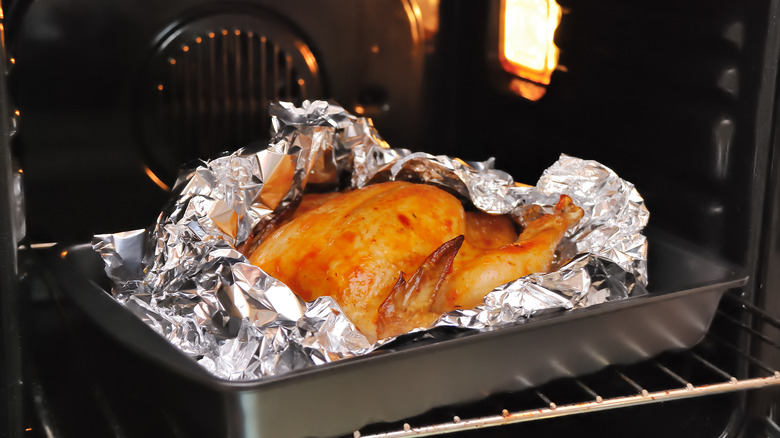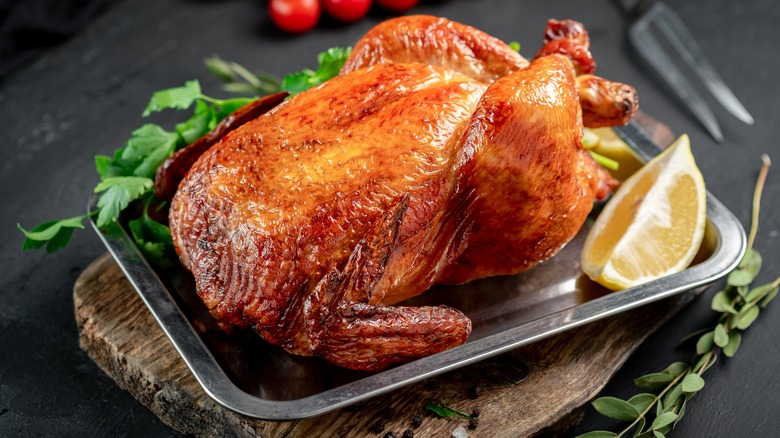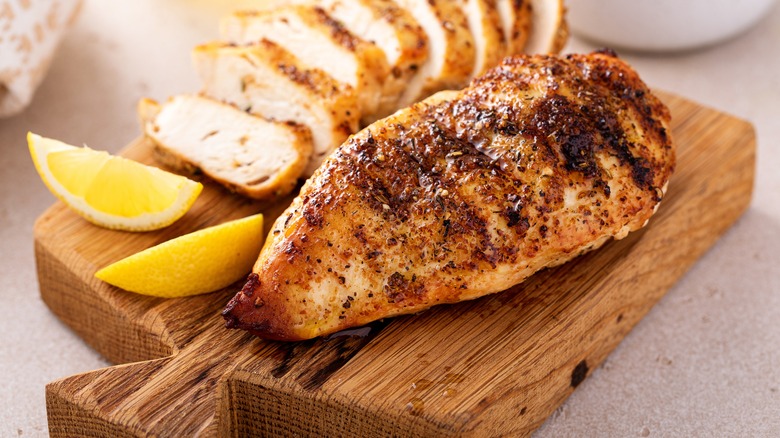12 Simple Tips That Will Keep Your Poultry Juicy And Tender
As an enthusiastic home chef, cooking poultry to perfection is a skill that should be near the top of your wish list. Poultry, particularly chicken and turkey, is often the star of large family gatherings, putting pressure on the home cook to get the cooking spot on. Unfortunately, achieving a perfectly tender and juicy serving of poultry can elude the best of us, and we all know how disappointing a dry, overcooked bird can be.
With a little preparation, however, it is possible to implement simple techniques that will increase your chances of success with your next family dinner. From selecting the best quality meat to resting it for the correct length of time, each step will move you toward your goal of poultry perfection. Join us as we take a look at the tips that will help you understand how to best cook this well-loved meat and ensure your poultry is tender, juicy, and delicious every time.
Choose pasture-raised meat
To start, selecting which product to buy is an important factor in how tender and juicy your poultry will be when it comes time to eat it. We all have various reasons for choosing ethically reared or local meat, whether it's better animal welfare, lower carbon footprint, or supporting local farmers. But you may not be aware that it actually affects the flavor and texture of the meat, too.
The way that poultry is raised plays a significant part in the quality of the meat. Pasture-raised birds are allowed to live as healthy and natural a life as possible. They eat food such as worms and natural grains that provide nutrients, rather than processed bird feed. They also have a much more active lifestyle than those that are kept in barns or cages. This means the meat is more nutritious, containing higher levels of heart-healthy omega-3 fatty acids and various vitamins. Additionally, this mimicking of their natural environment leads to more tender meat with much more flavor than conventionally raised poultry. So, when faced with the choice at your grocery store, opt for pasture-raised chickens whenever possible to satisfy both your ethics and your tastebuds. That said, don't worry too much if it's simply not an option for you financially or for other reasons; there are many other easy tips to make whatever poultry you have come out mouthwatering and superb.
Marinate poultry before cooking
In the midst of our high-paced lives, we often look for the quickest possible option for dinner, meaning the thought of marinating poultry in advance is a no-go. But there are so many benefits to marinating meat that go beyond flavor to make it worth your while spending a few minutes mixing up a marinade and coating your meat in it.
Marinating elevates your meal in two ways: It infuses flavor into it as the herbs, acid, and spices soak into the poultry to transform the flavor, and it helps keep the meat tender and juicy. Furthermore, citrus marinades in particular begin to break down the meat due to the acid in the juice, making the poultry more tender.
The longer you leave the meat to marinate, the better the flavor and tenderness will be. Ideally, prepare everything the night before, and leave your chicken or turkey to soak in the fridge in the magical marinade for a whole day before cooking. Flavor-wise, you can add anything you want, from honey and mustard to hot chili powder. Just be sure to include lemon or lime juice to maximize the tenderizing effect.
Baste poultry as you cook
Basting meat can be a time-consuming step, but the difference it makes to poultry is significant, so it's definitely worth the effort. Basting a chicken or turkey means coating it in a liquid periodically as it cooks, usually using its own juices from the bottom of the pan. This technique enhances the meat by adding depth to the flavor and keeping the poultry moist.
To baste your bird, first decide what basting mixture you're going to use. The easiest option is to spoon or brush the fat that has already melted into the baking pan back over the bird. You can also make a mixture yourself, using butter and any kind of flavorings you wish, or you could use the marinade if you've already coated the meat before cooking. If you own a turkey baster, now is the time to use it. This simple gadget allows you to apply the mixture evenly to the whole bird without the danger of getting burned by the hot fat. Otherwise, apply the liquid all over with a spoon, ladle, or pastry brush.
As well as locking in moisture and flavor, basting poultry gives the bird a beautiful golden shine that will enhance the presentation, too — handy if the chicken or turkey is to be the centerpiece of your family dinner. So, if you have time, baste the bird as often as possible throughout the cooking process to ensure the meat is tender, juicy, and delicious.
Choose the best cooking method
As you would expect, the way you cook your poultry is one of the most crucial aspects of achieving meat that is tender and moist, and the best cooking method depends on the cut of meat. Whatever cut of poultry you are preparing, think carefully about the cooking method that will suit it best, as this is definitely not a situation where one size fits all. When cooking a whole bird, for example, roasting is the most suitable method, since pan-frying is impractical. Darker meats, such as thighs and drumsticks, benefit from slow cooking, giving the fattier cut time to break down and become succulent.
Chicken breasts are notoriously one of the hardest cuts of poultry to get right, despite being the most popular. For a juicy chicken breast that is crisp on the outside, a combination of cooking methods is your best option. Sear the meat on both sides first in a hot frying pan, then cook in the oven for around 20 minutes. Using an oven-proof pan means you can transfer the chicken directly into the hot oven without losing any of the delectable juices that may have already melted into the pan. (Don't forget to use them for basting!) This combination of cooking methods means you get a golden crust on the outside and a perfectly moist center, resulting in a chicken breast that is tender and delicious.
Consider brining the bird
One method of keeping poultry tender that you may be less familiar with is the process of brining. It takes a little bit of forward planning but results in perfectly juicy meat with a salty kick.
Brining, as the name suggests, involves covering your poultry in a salt water solution, along with whichever seasonings you wish. You will essentially give the bird a brine bath for as long as possible — 24 hours if you can. The brine works by breaking down the proteins in the meat, which prevents it from drying out once it is cooked. The added benefit of the salt water is that it seasons the meat thoroughly since it has time to soak deeply into the flesh. Any other seasonings you add to the brine mixture will also infuse into the meat. Garlic, fresh or dried herbs, spices, and citrus are all great options to add real depth of flavor to the bird.
You can either brine a whole chicken or turkey (which requires a big bowl), or you can brine individual joints, which may be more manageable. The bigger the piece of meat, the longer you will need for effective brining. A small chicken breast will need less than an hour, whereas a whole turkey could take two full days.
Tenderize the meat
If you haven't had the opportunity to prepare your meat in advance and are looking for a last-minute technique to make your turkey or chicken breast juicier, tenderizing is a great option. Chicken and turkey breast are difficult to cook well since the middle of the portion is usually much thicker than the rest, meaning that by the time the center is cooked properly, the outsides will be overdone and dry. Pounding the meat to an even thickness can prevent this (as well as allow you to take out some of your frustrations from the day at the same time).
A meat mallet is of course the perfect tool for this job, but in its absence, a rolling pin will do nicely. Place the poultry in a plastic food bag to reduce the mess, and pound the meat evenly until it reaches a uniform thickness of ¼ inch. Achieving an even thickness means the heat will be distributed equally, and it will reduce the chance of overcooked meat. Pan-frying poultry is much easier with a tenderized breast, meaning you can whip up a quick midweek meal in much less time.
Use a meat thermometer to avoid overcooking
One crucial aspect of cooking poultry while keeping it tender and juicy is to ensure you don't overcook it. The most accurate way to measure this is with a meat thermometer, to hit that perfect spot between slightly underdone and dry and tough. If you're used to cutting into the meat towards the end of the cooking to check its doneness, let a thermometer take the guesswork out of it for you.
The magic number you're aiming for is 165 degrees Fahrenheit, which is the point at which poultry is safe to eat but should still remain moist and tender. Be sure to check the thickest part of the meat, and if you are cooking a whole bird, test the breast, wing, and thigh separately. Bear in mind that poultry can continue to cook once out of the oven, so consider removing it from the heat just a few degrees under to allow it to reach the perfect temperature.
Favor cuts of meat with a higher fat content
Though chicken breast is the most common cut of chicken, it's neither the most flavorful nor the most tender. It has very little fat, making it a favorite choice atop a salad for the health-conscious, but its lean nature means it tends to be dry in comparison to the rest of the bird. When looking for a tender cut of chicken or turkey, you'll have more success if you gravitate towards the higher-fat cuts of meat, such as the thighs and drumsticks. Their higher fat content, coupled with more connective tissue that breaks down during cooking, means that poultry legs get more tender the longer they are cooked. As the fat melts, it makes the meat moist and juicy and prevents it from drying out.
Since leg meat benefits from a long, slow cooking time, the chances of you overcooking it and spoiling the meal are very slim. Compare this to chicken breast, which has a very narrow window of doneness before it will need to be doused in gravy just to be edible, and the cut for your next chicken dish should be an obvious choice.
Remove poultry from the fridge before cooking
Most of us, when cooking poultry, choose to keep the meat in the fridge until we are ready to cook, transferring it straight into the pan or oven. As well as being convenient, this means the meat is kept at a safe temperature for as long as possible. However, if you want your poultry to be cooked properly and, therefore, tender and moist, it's important to remove it from the fridge and allow it to warm slightly before cooking. Regardless of the cut, the center of the chicken or turkey is always going to take longer to cook than the outside. The colder the meat is when it hits the heat, the more extreme the difference in cooking time will be. The disappointing result of this will be meat that is overcooked and dry on the outside or undercooked in the middle.
That said, there is a balance to be found, as leaving poultry at room temperature for a long time is not a good idea. Bacteria multiply fastest between 40 and 140 degrees Fahrenheit, meaning room temperature chicken can be a breeding ground for microbes that can cause food poisoning (via USDA). Taking your poultry out of the refrigerator around 20 minutes before cooking should allow for the ideal compromise of perfectly moist chicken without increasing the risk of anyone becoming ill.
Cover poultry with aluminum foil
When it comes to hacks that can keep your poultry tender and juicy, there is one that is simpler than the rest — aluminum foil. Taking a few seconds to cover the bird with foil before cooking can make a huge difference to the moisture retention, so it is very much a good use of your time.
Before covering the bird in foil, you need to decide how you want the skin to come out. If the most important factor is the meat inside, you should cover the bird entirely with foil. This will keep the heat in, causing the turkey or chicken to steam as it cooks, resulting in a super moist bird in a shorter amount of time. If you're looking for crispy skin, you'll need to form a tent with the foil. This way, the skin can crisp up underneath the aluminum, but it will take longer for the bird to cook overall.
A compromise may be to roast with aluminum foil for most of the time, then remove it toward the end, allowing the skin to crisp up during the last few minutes of cooking. No matter what method you use, a simple sheet of aluminum foil can be your greatest ally in the search for perfectly cooked poultry.
Rest the bird after cooking
There's one essential tip for cooking poultry that doesn't involve cooking at all; it requires the meat to be rested as soon as the cooking is finished. Most of us have heard of resting meat but may not understand what it actually means. If you have ever cut into a steak as soon as it has finished cooking, you will have seen the result of not resting meat: blood will spill out onto the plate. Not only does this make the dish unappetizing, but it will make the meat less juicy. The same applies to poultry; letting it rest after cooking allows the juices to be absorbed back into the meat where they belong, keeping it moist and flavorful.
You may be thinking that this means leaving the chicken or turkey out for a few minutes before serving, but if you have cooked the bird whole, you'll need to allow for a lot more time than that. According to Gordon Ramsay, a whole turkey should be left to rest for a minimum of 45 minutes and as much as a few hours! This will allow the juices to make their way from the surface back down into the meat, which is where you want them to be. Creating a foil tent over the bird will help it to retain its heat while it rests.
Cut against the grain
The last step for keeping your poultry tender happens just before you plate your dish. How you slice your chicken or turkey breast doesn't just affect the presentation on the plate; it can impact the texture of the meat, too. Slicing meat against the grain means cutting across the muscle rather than along the length of it, shortening the fibers in each slice. This makes it easier to chew and more enjoyable to eat. This is particularly significant in lean cuts like breast meat, as they don't have enough fat to naturally lend moisture.
The issue with poultry is that the direction of the grain can be difficult to spot against the pale color of the meat. Slicing the breast in half will make it easier to spot the grain, allowing you to cut the meat in the opposite direction. Although this has a more significant effect on red meat, such as steak, it can still make a difference to your poultry, so it's worth taking a few seconds to find the correct direction before slicing. This simple act could be the difference between serving up a good meal or a great one.

